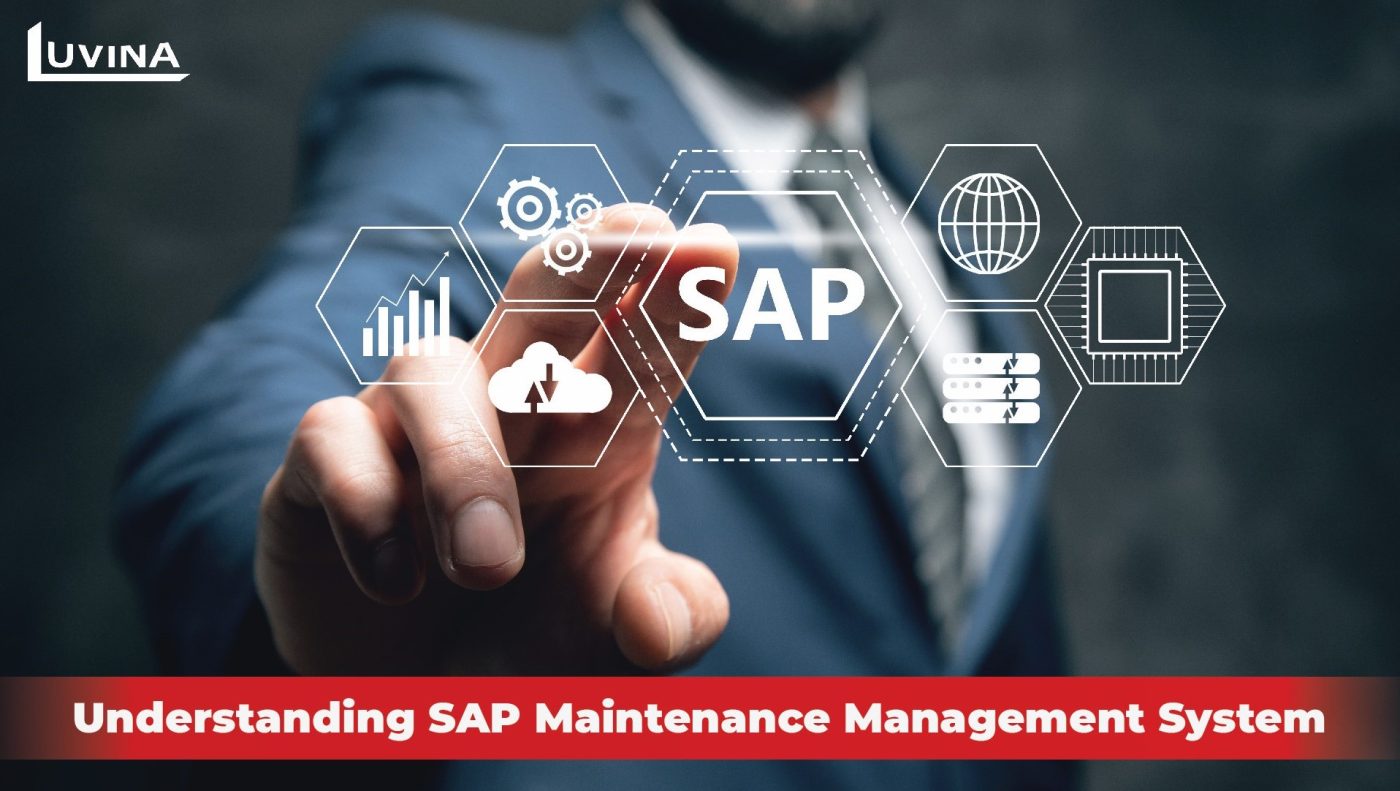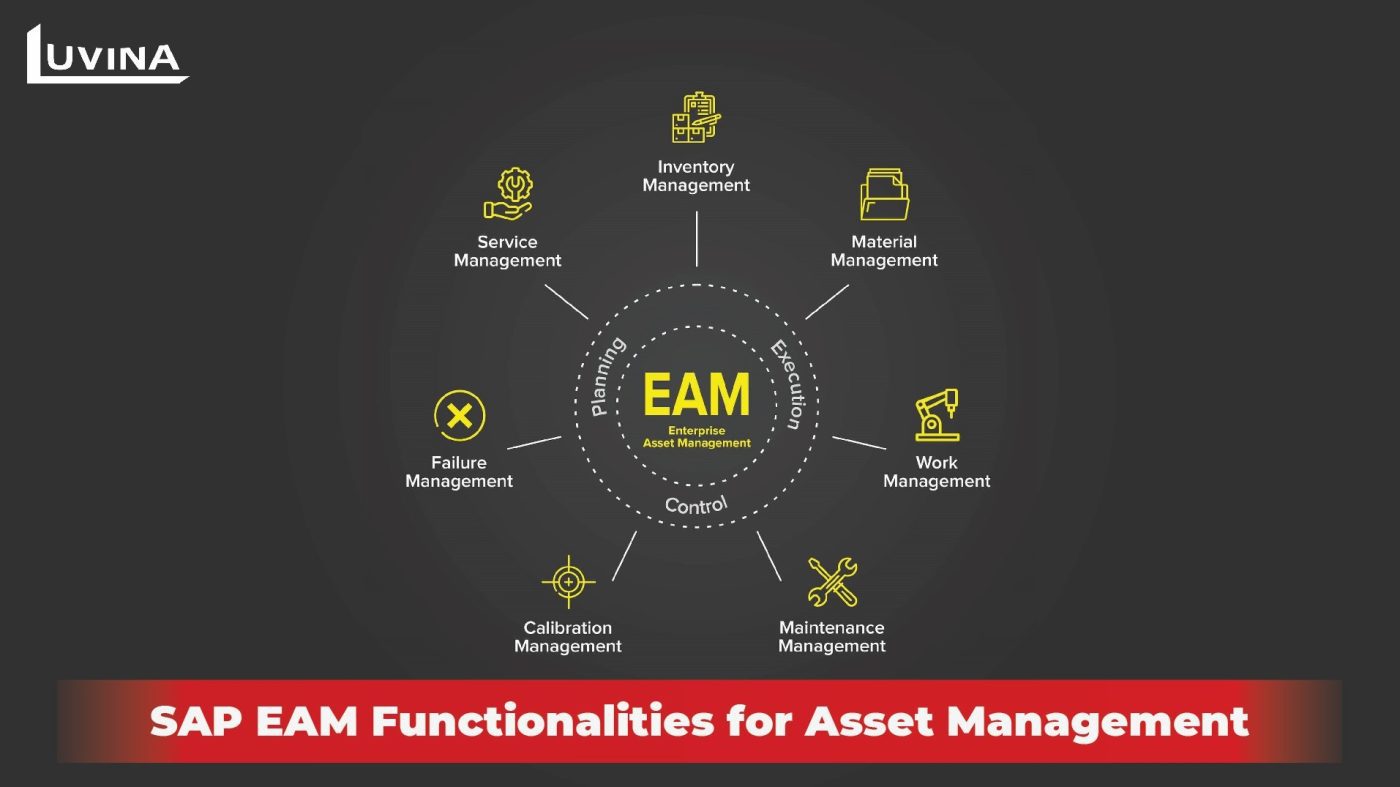SAP’s Maintenance Management System stands as a beacon of efficiency within the realm of organizational upkeep. This suite of software solutions, meticulously curated by SAP, is purpose-built to revolutionize and refine maintenance processes across diverse industries. Imagine a comprehensive toolbox meticulously designed to streamline and optimize maintenance operations within organizations of all scales and complexities. From small-scale enterprises to multinational corporations, SAP’s suite is engineered to propel maintenance management to new heights of effectiveness and precision.

Benefits of SAP Maintenance Management System
The benefits of the SAP Maintenance Management System are significant:
1. Improved Asset Reliability and Uptime
The benefits of adopting an SAP Maintenance Management System are substantial and wide-reaching. One of the key advantages lies in its ability to enhance asset reliability and maximize uptime. By implementing preventive maintenance strategies, the system ensures that assets remain consistently operational, minimizing instances of unexpected breakdowns and associated downtime. This reliability improvement translates into sustained productivity, streamlined workflows, and optimized resource utilization within an organization. Businesses can count on their assets to function seamlessly, leading to improved operational efficiency and a reduction in the losses incurred due to unplanned downtimes.
2. Enhanced Operational Efficiency
SAP Maintenance Management System contributes significantly to operational efficiency by streamlining maintenance processes and minimizing downtime. Through the implementation of preventive and corrective maintenance strategies, the system optimizes workflows, ensuring that assets remain operational for longer durations. This reduction in downtime directly translates into improved operational efficiency, as it minimizes disruptions and allows for consistent productivity. By efficiently managing work orders, tracking asset conditions, and facilitating timely maintenance, the system fosters a smoother operational environment, enabling businesses to operate more effectively and meet their production or service targets efficiently.
3. Better Resource Utilization and Cost Control
SAP Maintenance Management System excels in optimizing resource utilization and bolstering cost control measures within organizations. By centralizing resource management, the system enables efficient allocation of manpower, spare parts, and equipment. This streamlined approach minimizes wastage, reduces unnecessary inventory stockpiling, and ensures that resources are allocated where they are most needed, contributing to reduced operational costs. Moreover, the system’s comprehensive reporting and analytics empower businesses to make informed decisions regarding resource allocation, allowing for better budget planning and cost control. This holistic view and management of resources translate into enhanced budget control and reduced operational expenses, fostering a more financially sound and resource-efficient operational environment.
4. Comprehensive View and Control
The SAP Maintenance Management System delivers a comprehensive, bird’s-eye view of maintenance processes, empowering organizations with enhanced control and efficiency. Through centralized data management, it offers a unified platform to oversee all maintenance activities, providing insights into ongoing tasks, work orders, and asset performance. This centralized approach streamlines operations by enabling quick access to critical information, facilitating better decision-making, and ensuring regulatory compliance. By offering this comprehensive view and control, the system allows for proactive management, quick issue resolution, and optimized resource allocation, ultimately enhancing operational agility and effectiveness across the organization’s maintenance landscape.
5. Data-driven Decision-making
The SAP Maintenance Management System harnesses the power of data-driven decision-making to drive continuous improvement and operational excellence. By leveraging comprehensive data analytics and reporting tools, it empowers organizations to make informed decisions. This data-centric approach enables the evaluation of maintenance performance, identification of trends, and prediction of potential issues, fostering a proactive rather than reactive maintenance culture. With these insights, organizations can optimize maintenance strategies, fine-tune processes, and allocate resources more effectively, leading to enhanced operational efficiency and sustained excellence.
Implementing the SAP Maintenance Management System offers multifaceted benefits, ranging from increased reliability to streamlined decision-making, fostering an environment of operational efficiency and control.
SAP Enterprise Asset Management (EAM)
When it comes to managing the lifecycle of your assets and ensuring their optimal performance, SAP offers a powerful solution: SAP Asset Management (EAM). This comprehensive system helps organizations achieve efficient maintenance through various functionalities, including:

1. Asset Register
The Asset Register, a pivotal feature within SAP EAM, functions as a centralized repository meticulously archiving indispensable asset particulars. Here, critical information such as asset location, comprehensive ownership history, and pertinent ownership details are meticulously cataloged. This centralized storage system ensures a comprehensive, holistic outlook on the organization’s physical assets, providing a foundation for informed decision-making and strategic asset management.
2. Preventive Maintenance (PM)
Preventive Maintenance (PM) stands as a cornerstone within SAP Asset Management (EAM), facilitating the scheduling and oversight of routine maintenance tasks. Leveraging usage patterns, manufacturer recommendations, and predictive insights, this feature enables proactive maintenance planning. By preemptively addressing potential issues, Preventive Maintenance helps thwart equipment failures and elongate the operational life of assets. Through meticulous scheduling and management, it ensures a proactive approach to maintenance, minimizing unplanned downtime and maximizing asset longevity.
3. Corrective Maintenance (CM)
Corrective Maintenance (CM) within SAP Asset Management (EAM) streamlines the management of repair work orders and breakdowns. This functionality enables the efficient dispatch of maintenance staff while overseeing spare parts inventory. By swiftly responding to reported issues and efficiently managing repair tasks, Corrective Maintenance ensures a rapid and effective resolution to equipment malfunctions. This proactive approach minimizes operational disruptions, optimizing asset performance, and ensuring smooth workflow continuity.
4. Inventory Management
SAP Asset Management (EAM) incorporates robust Inventory Management capabilities, facilitating automated monitoring of stock levels and predefined reorder points for spare parts. This automated system ensures the timely availability of maintenance resources, eliminating delays in addressing maintenance needs. By efficiently managing spare parts inventory, organizations can optimize their maintenance operations, minimize downtime, and ensure swift and effective responses to asset maintenance requirements.
5. Work Management
Work Management within SAP Asset Management (EAM) enables streamlined assignment and execution of maintenance tasks. It provides a structured system to assign tasks efficiently, track technician performance, and optimize resource allocation. By monitoring and managing these aspects, organizations can enhance the overall effectiveness and productivity of maintenance operations, ensuring tasks are completed promptly and with optimal resource utilization.
6. Cost Control
Cost Control in SAP Asset Management (EAM) incorporates comprehensive cost analysis reports, enabling effective budget planning and identification of potential cost-saving opportunities. These detailed insights help organizations streamline their financial strategies, optimize asset management, and identify areas where operational costs can be minimized, ensuring a more efficient and cost-effective approach to asset maintenance.
7. Mobile Capabilities
The mobile capabilities within SAP Asset Management (EAM) offer accessible applications, providing technicians and supervisors with the power to manage maintenance tasks and access crucial information remotely. This convenience ensures efficient task management, swift decision-making, and seamless connectivity, ultimately enhancing overall operational agility.
SAP EAM’s comprehensive functionalities encompass the entire spectrum of asset management, ensuring streamlined operations and optimal resource utilization.
Examples of SAP EAM in Practice
1. Manufacturing
In the realm of manufacturing, a pivotal strategy embraced by plants involves leveraging the capabilities of SAP EAM to proactively schedule preventive maintenance for vital production equipment. By adopting SAP EAM, these facilities ensure a meticulous and timely schedule for maintenance activities on key machinery. This proactive approach not only safeguards against potential breakdowns but also guarantees uninterrupted production runs, significantly reducing downtime. The utilization of SAP EAM in this context becomes instrumental in maintaining optimal operational efficiency, securing seamless production cycles, and fortifying the plant’s productivity while curtailing potential losses due to equipment malfunctions.
2. Transportation
In the logistics domain, SAP EAM becomes the bedrock of operational efficiency for companies managing a fleet of vehicles. A logistics firm harnesses the capabilities of SAP EAM to meticulously track and maintain a comprehensive maintenance history for its entire fleet. Leveraging this system allows them to optimize service intervals for each vehicle based on historical data and predictive analytics. This strategic implementation not only ensures the vehicles are well-maintained but also aids in enhancing the firm’s on-time delivery performance. Through SAP EAM, the logistics company achieves a fine balance between proactive vehicle maintenance and optimizing delivery schedules, thereby fostering increased reliability and efficiency in their operations.
3. Facilities Management
In the realm of facilities management, SAP EAM serves as the cornerstone for a building management company seeking seamless maintenance operations. Leveraging SAP EAM, the company adeptly orchestrates and oversees repairs and maintenance across a diverse portfolio of facilities. This meticulous management ensures that every aspect of the buildings is well-maintained, thereby optimizing their overall performance. By utilizing this system, the company ensures prompt responses to maintenance issues, contributing significantly to tenant satisfaction. SAP EAM becomes an integral tool for the company, enabling them to maintain impeccable facilities while fostering a positive experience for their tenants through swift and efficient maintenance processes.
Crucial Steps While Considering SAP EAM for Your Organization
1. Evaluate Your Needs: Begin by understanding your asset management challenges and the functionalities you require. Identifying these specifics will help align SAP EAM features with your organizational needs.
2. Analyze Cost and Benefits: Assess the costs of implementing SAP EAM against the potential gains in efficiency, cost savings, and improved asset performance. This analysis will help determine the system’s overall return on investment.
3. Consult with Experts: Collaborate with SAP partners and consultants to ensure a successful implementation. Their expertise will help tailor SAP EAM to your organization’s unique requirements, maximizing its benefits.
Taking these steps will aid in making an informed decision about adopting SAP EAM, ensuring it aligns with your organization’s goals and delivers the expected value.

Conclusion
SAP’s Maintenance Management System offers a suite of tools and functionalities tailored to effectively manage maintenance processes, optimize asset performance, and ensure operational excellence within organizations.
Looking to harness the power of SAP EAM for your organization’s asset management needs? Contact Luvina today and embark on a journey toward streamlined maintenance processes, optimized asset performance, and enhanced operational efficiency. Let Luvina guide you through implementing SAP EAM and unlock the potential for seamless asset management and maintenance excellence.
{ Get everything you ever
wanted to know about IT.}
Read More From Us?
Sign up for our newsletter








Read More From Us?
Sign up for our newsletter
Read More From Us?
Sign up for our newsletter